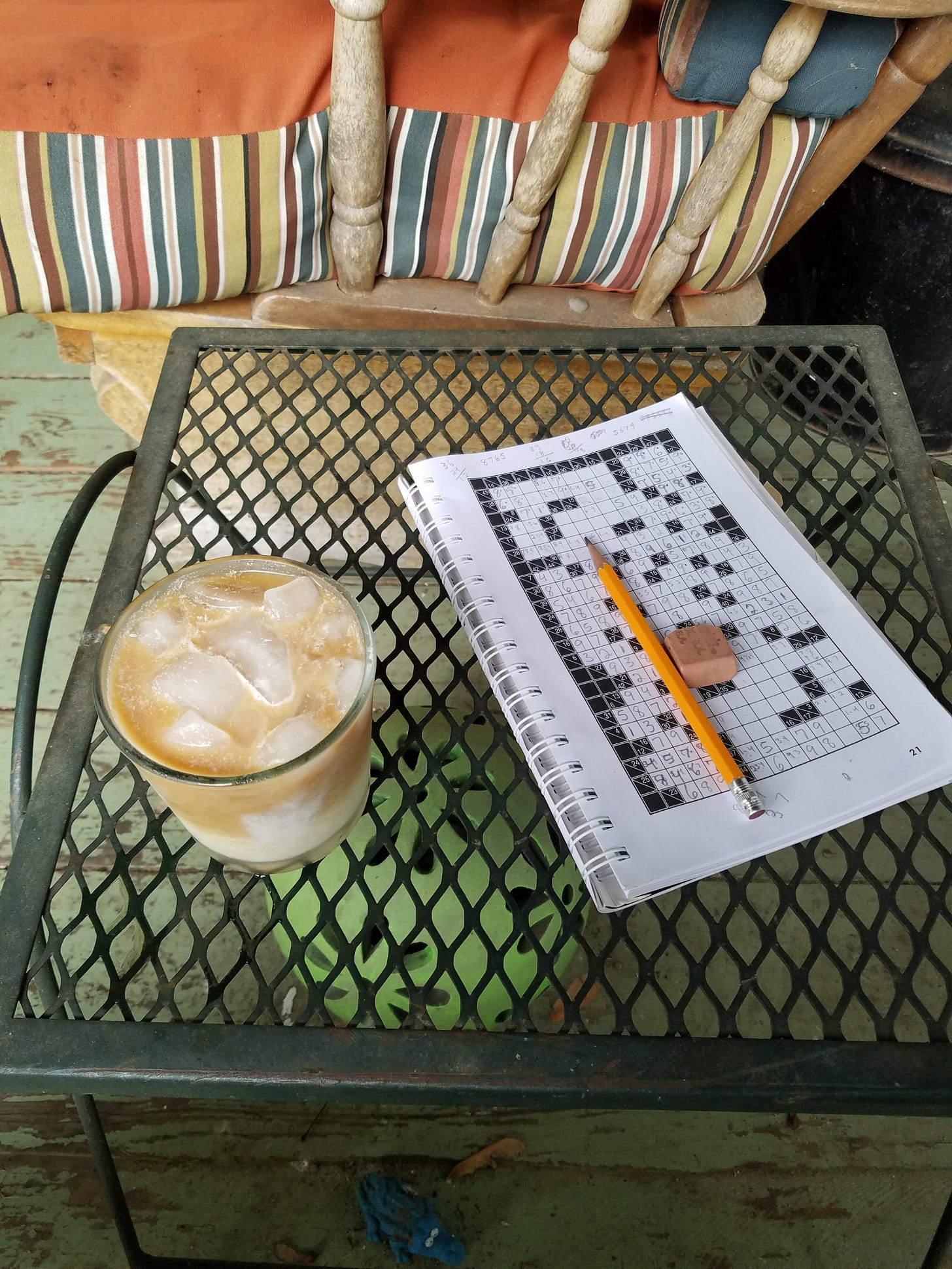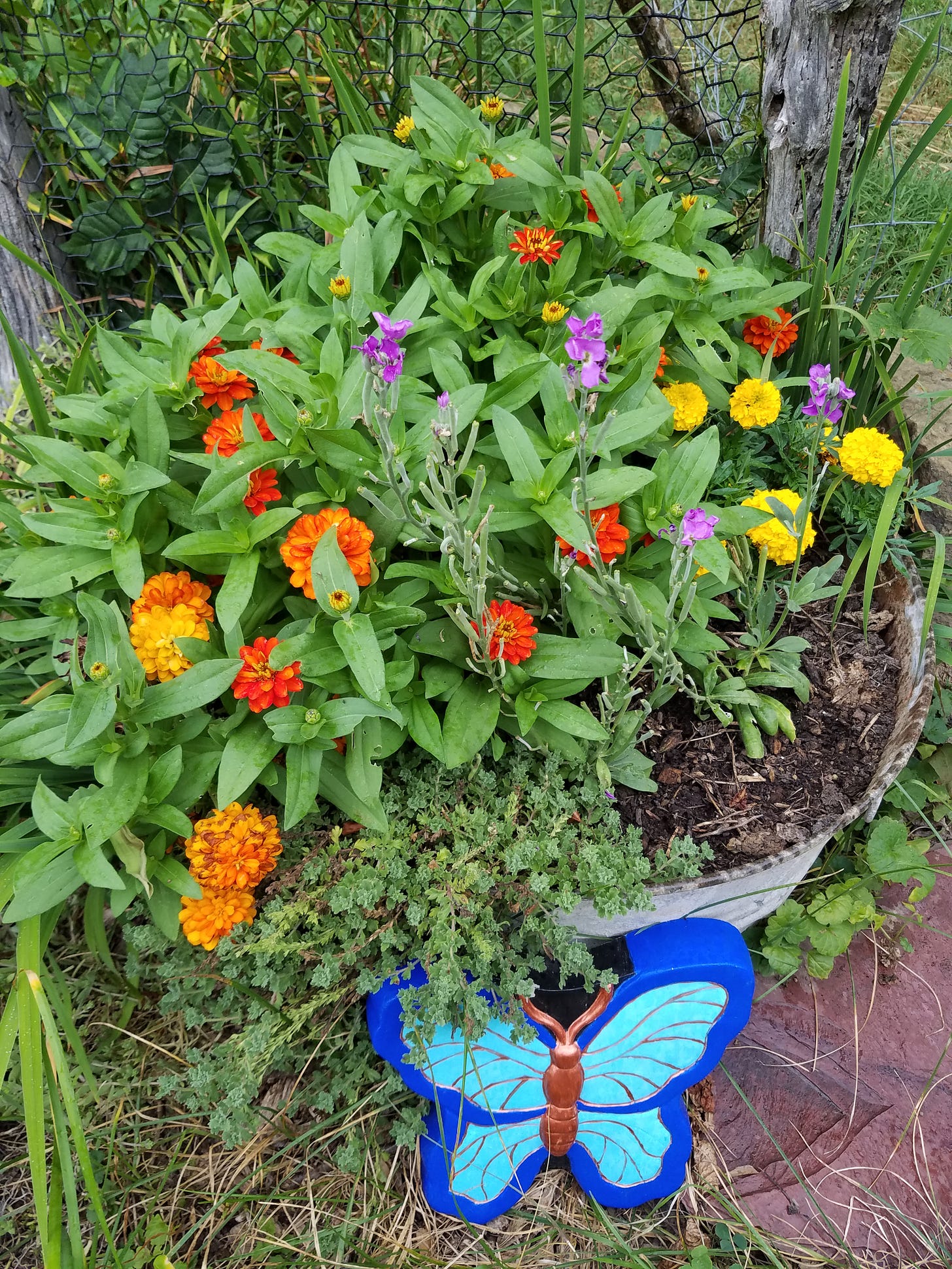View from the garden bench
I write these words on the last day of June, during a miserable hot spell. It's not strictly true, as I often hear, that the hottest weather comes in July and August. Some years June is the worst, and I hope that is the case this season. In the heat I spend much less time in the garden: I mostly harvest and keep paths navigable. Each day I water a few plants, whichever ones need a drink the most.
I fenced out the deer years ago, and insect problems are minimal, most likely due to good soil and a healthy population of birds and predatory bugs. My main enemy in the garden is voles, whose numbers seem high this year. When I see healthy plants wilt overnight because their roots have disappeared, I know it is the work of voles.
New plant this year: bitter melon
I've been laying sheets of cardboard over beds during the winter months. This practice is quicker than mulching and creates a ready-to-plant, weed-free bed in spring. I've learned it also creates vole heaven since the little buggers can move freely and safely under this insulating cover. I definitely won't be using the cardboard method any longer.
I've found potato and summer squash plants lying rootless on the soil surface, and the pests have even affected the onion harvest. Apparently onion roots do not have the strong flavor of the bulbs that deters nibbling. After harvesting cabbage and garlic, I add loads of compost and dig it in deeply to counteract the action of Asian jumping worms. I hope I'm collapsing tunnels and discouraging rodent activity as well.
The bean wall will eventually provide afternoon shade for bench sitters
Unlike many gardeners, I believe disturbing soil is okay, and distinguish between tilling and digging. Mechanically pulverizing soil year after year destroys it, leaving a lifeless media for extractive agriculture. The average individual will do very little damage messing around in the garden with a shovel however, and it can be beneficial if you're hoping to disrupt pests, as I am.
Strictly speaking, if I only disturb the top four to five inches of material, I'm not even hitting soil, just the layer of organic matter that lies atop it. Soil is defined as a mixture of air, water, mineral particles of sand, silt, and clay in varying proportions, as well as organic matter. I like to bring up the underlying clay to enrich the layer of compost. This might sound backwards, but negatively charged clay particles hold onto positively charged plant nutrients, preventing leaching, while clay also improves moisture retention and enhances buffering capacity. Also I just really enjoy mixing it up from time to time.
Patio baby, my favorite eggplant to grow
I've attempted to write some Big Idea posts lately, but they languish in the drafts folder. Heat waves are not a good time for Big Ideas. Heat waves are a good time for porch sitting, iced coffees, and pasta salads.
Wondering if local conditions met the official criteria for a heat wave, a heat dome, or a drought, I did some internet diving. Depending on who you ask, a heat dome is either just a fancier term for heat wave, or a distinct weather phenomenon characterized by a stalled high pressure system. A heat wave is merely a period of two or more days of abnormally hot weather.
Last week we apparently experienced a heat dome, but it's hard to say if we're in a heat wave now, absent a definition of what constitutes “abnormally hot.” I remember days of sticky misery during childhood when not a breath of air stirred and we retreated to our cave-like basement with its sweating earthen walls to pass the heat of the day. The question is raised, what qualifies as abnormal when a typical summer day here is over 90°?
The National Integrated Drought Information System website, on the other hand, will tell you definitively if your area is in a drought. Or so I thought. The line on the map separating moderate drought areas from those merely abnormally dry runs right through the farm, so I guess I can take my pick. With stock tanks nearly empty and no rain in the forecast for the next few days, I feel comfortable using the ‘d’ word.
Iced coffee and some kakuro
The heat and the drought are nasty, but if I could wish away one bad thing it would be the rats. We've been battling them for months now, and have only four confirmed kills, thanks to my boyfriend and his 22 caliber pellet gun. (He also caught a large rat snake and set it loose near a tunnel, into which it immediately disappeared.) They have ignored the live trap. Not only did they successfully trigger the snap trap and retrieve American cheese covered in peanut butter, they also removed the spring mechanism entirely and absconded with it. We are also missing a black insulated metal tumbler with a lid.
As soon as I caught on to the scope of the problem, I started removing all feeders at night, but the rats would still enter the chicken room to drink and bathe. One morning I found the water low and soiled, and a wood strip with a long crack placed like a clothespin on the edge of the repurposed milk jug I use for a waterer. To aid the young ones in and out of the bath? To climb up and do cannonballs off of? I can only guess.
Since the onset of the rat infestation I've wondered what role rats play in a permaculture system. Do I have, not a rat problem, but rather a terrier deficiency? How can I bring things back into balance in order to equilibrate the rat population? What are rats telling me about the health of my system? Just kidding. Rats play no role except that of highly destructive, viciously intelligent disease carriers.
Garden entrance
The main message of the rats is that someone in the neighborhood had rats and didn't deal with them, and that I was a lucky fool all those years when feeding the chickens meant filling feeders and walking away. Now I only throw to them what they can clean up in five minutes or so, and lids of storage cans are always securely replaced. We are trying to starve them out (doubtful) or at least use hunger to force them into the open to be blown to smithereens with a lead pellet.
The only good thing about having rats is I've gotten to know my chickens better from observing them while they eat, an insignificant benefit. The only meaningful contribution I can think of that rats could make to the ecosystem is as food for hawks and owls. Though hawks of various species patrol the skies by day, and owl calls are heard by night, they make no dent in the rat population. Apparently there is prey much easier to catch than rats. We hope to change that as they become more desperate for food and are forced to range farther afield. Meanwhile there is the pellet gun. Also I just read that rats can only go a day or two without water, and by removing all waterers when I shut the chickens in for the night, I might add some additional stress to their lives. The drought might have a faint silver lining.
Rat living in hazelnut bush











At the risk of being annoying, I'm gonna say rats get a bad rap. Doing some quick research I'm reading that rats are "synanthropic" which means for many thousands of years they've enjoyed hanging out where the humans are. This helps explain some of their very human-like characteristics. In the city, it's discarded human food that attracts them since there are very few chicken coops. I'm struck by the fact that virtually everybody hates them usually with no just cause except "they spread plague." (Recently scientists have concluded that the black death was airborne and rats were just the fall guys.) I see them scurrying along our back fence sometimes but they never come into our house which the mice occasionally do, and personally I figure live and let live. I see them as interesting creatures and I do my best to coexist. By the way, what is that cute little dog-faced animal just above the egg plants in your photo? Am I the only one who sees him?
You may want to try and locate people in your area that raise and hunt with mink as a hobby. One morning's work with a pair of mink in your hen house, will solve your problem...at least for a while. Lovely photos, btw. Your eggplant looks yummy.
On the wildlife-reestablishing-themselves-in-their-former-range front, a pair of sea otters has reestablish themselves on the northern Oregon coast, for the first time in 120 years. While our controllers screech at us for eliminating species with human overpopulation, all across the United States I find wonderful stories of wildlife recolonizing former habitat ON THEIR OWN. I've come up with two reasons why this good news is not being celebrated. #1 It seems to take about 50-100 years after strict hunting/trapping laws, for natural rebound in species population. I don't think think those in charge of our wildlife management ever in their wildest dreams, realized how quickly wildlife could rebound with proper hunting/trapping protection. They can't admit they got it wrong. #2 Admitting the return of a population listed as exterperated, means an expensive, and perhaps controversial management plan. Hence , we hear from our state government bureaus: "these are lone individuals just passing through". They are not fooling those if us interested in this subject.